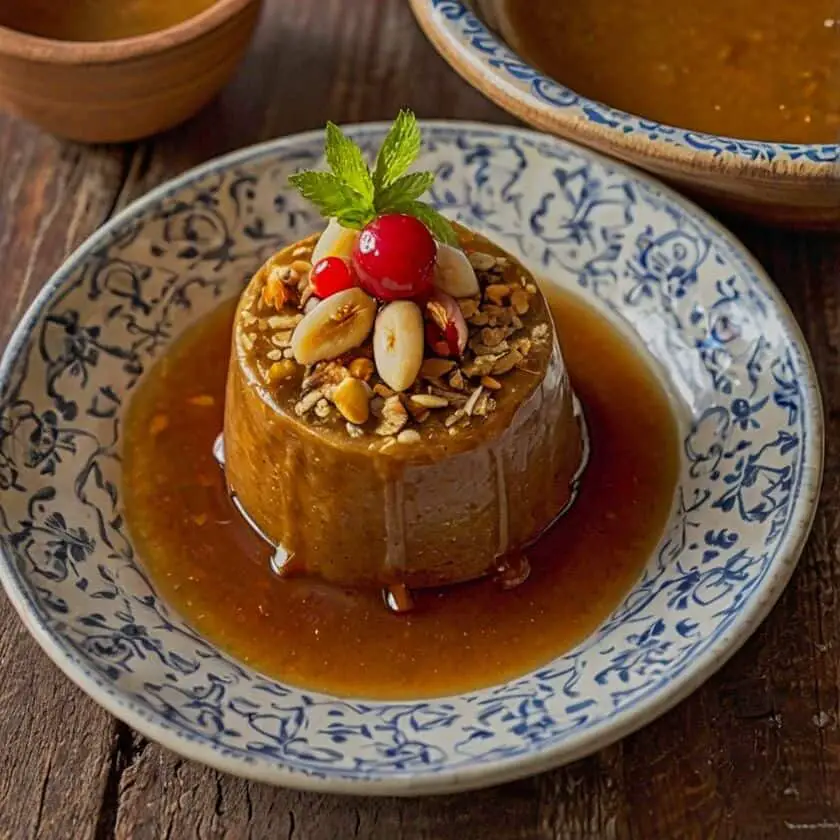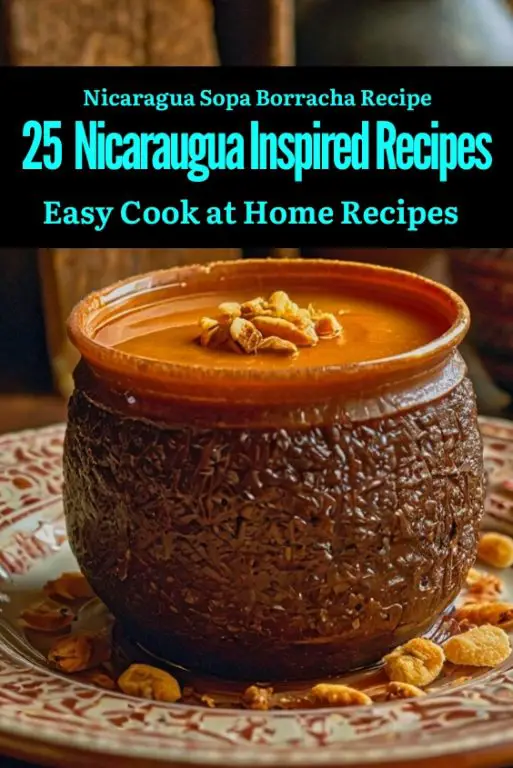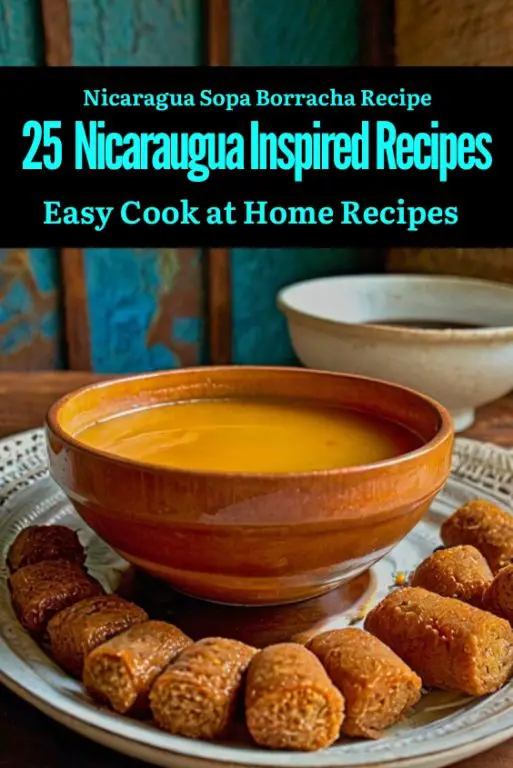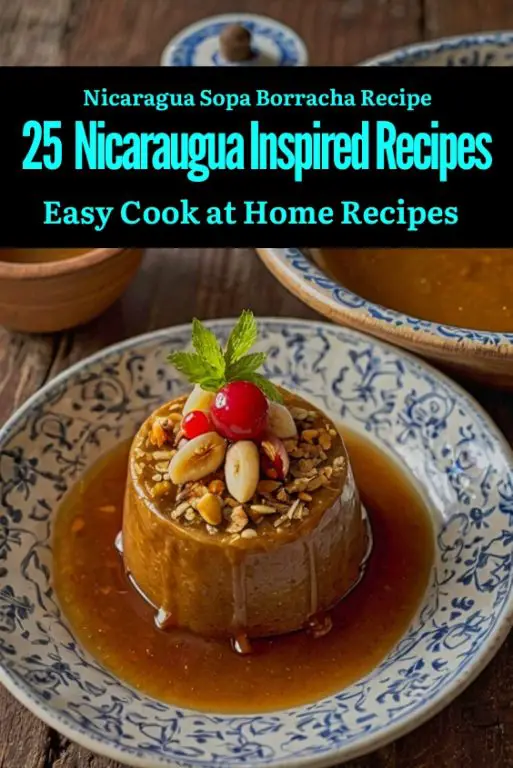Sopa Borracha, a word that translates to “drunken,” perfectly describes this delightful Nicaraguan dessert that is both rich and indulgent. The Sopa Borracha recipe, much like its Panamanian counterpart, is a staple in Nicaraguan celebrations. This delicious sweet treat is a sponge cake soaked in a flavorful rum syrup and often accompanied by dried fruits such as raisins and prunes. The cake takes center stage at various gatherings, from birthday parties to holiday feasts, and I find it nearly impossible to resist its inviting aroma and decadent taste.
The origins of the Sopa Borracha recipe reflect a blend of Nicaraguan and broader Caribbean influences. While the dessert has similarities with the popular rum cakes found throughout the Caribbean, Nicaraguan Sopa Borracha recipe carries a unique twist of its own. The recipe is simple yet requires some time to allow the flavors to meld beautifully, making it a labor of love that is well worth the wait.
To create the perfect Sopa Borracha recipe, I start with the cake, traditionally using a light sponge or bizcocho that will easily soak up the boozy syrup. The magic begins the night before, as I prepare the dried fruits. I combine raisins and prunes in a jar, pouring a generous amount of Nicaraguan rum over them. I secure the lid and let the fruit absorb the liquor overnight, allowing their flavors to deepen as they soak up the spirit. The next day, I strain the fruit, saving the soaking liquid to create a flavorful syrup.
The syrup is where the real fun begins. I measure out the reserved liquid and add it to a pot with granulated sugar and a mix of spices, such as cinnamon and cloves. I bring the mixture to a gentle boil, letting the syrup thicken and develop a rich, aromatic flavor. Once it’s ready, I strain out the spices and fold the soaked fruit back into the syrup, which I then store in the fridge until I’m ready to assemble the dessert.
Next for the Sopa Borracha recipe comes the sponge cake batter. It’s important to separate the egg whites from the yolks while they’re still cold, as it makes the process a little easier. After allowing them to come to room temperature, I whip the egg whites until they become fluffy and form stiff peaks, then gradually add sugar to reinforce the structure. This step is key to creating that light, airy cake that will soak up the syrup without falling apart. I then carefully fold in the egg yolks and milk, followed by the flour, watching the batter transform into something magical.
After pouring the batter into a prepared baking dish and baking it to golden perfection, I cut it into bite-sized pieces to prepare for soaking. I generously drizzle the prepared syrup over the cake, making sure each piece is well soaked. I allow it to rest either for a few hours or, ideally, overnight. The longer it sits, the more deliciously boozy it becomes.
To serve the Sopa Borracha recipe, I place several pieces of the soaked cake into a glass, adding spoonfuls of the soaked fruits on top. A final drizzle of syrup ensures every bite is bursting with flavor, and a sprinkling of colorful sprinkles adds a festive touch. I love to share this Nicaraguan treasure with friends and family, as every slice brings with it a celebration of culture and community.
Ingredients For the Nicaraguan Sopa Borracha Recipe
Loaf of White Bread (16 ounces)
Cup of Rum
Milk
Granulated Sugar
Raisins
Chopped Nuts (e.g., almonds, walnuts)
Unsalted Butter
Cocoa Powder
Ground Cinnamon
Zest of 1 orange
Zest of 1 lemon
Powdered Sugar
Cooking Instructions For the Nicaraguan Sopa Borracha Recipe
- Cut the white bread into thick slices, about 1 inch in thickness. In a shallow bowl, combine the rum and milk. Dip each slice of bread into the rum-milk mixture, ensuring they are well-soaked. Place the soaked bread slices in a single layer on a baking sheet and set aside.
- In a small bowl, combine the granulated sugar, raisins, chopped nuts, and ground cinnamon.
Mix well until all the ingredients are evenly distributed. - In a saucepan, melt the unsalted butter over medium heat. Add the cocoa powder, orange zest, and lemon zest to the melted butter. Stir well until combined. Take a baking dish and spread a thin layer of the cocoa-butter mixture on the bottom. Place a layer of the soaked bread slices on top of the cocoa-butter mixture. Sprinkle a generous amount of the raisin and nut mixture over the bread layer.
- Repeat the process, adding another layer of soaked bread slices and the raisin and nut mixture. Continue until all the ingredients are used, ending with a layer of the raisin and nut mixture on top.
- Once the layers are assembled, cover the baking dish with plastic wrap and refrigerate for at least 2 hours or overnight. This resting time allows the flavors to meld together and the bread to absorb the delicious rum and cocoa-butter mixture.
- Before serving, remove the Sopa Borracha from the refrigerator and let it sit at room temperature for a few minutes.
- Optionally, dust the top of the dish with powdered sugar for added sweetness and visual appeal.
Cut the Sopa Borracha into individual portions and serve chilled.
Eating Healthy in Nicaragua
Eating healthy in Nicaragua is a natural and accessible option, thanks to the abundance of fresh, locally sourced ingredients available throughout the country. Nicaraguan cuisine, while known for its hearty and comforting dishes, also offers many opportunities for nutritious and balanced meals. Fresh fruits and vegetables, such as avocados, tomatoes, and plantains, are staples in many traditional dishes and are readily available in local markets. Fruits like papaya, mango, and pineapples, rich in vitamins and antioxidants, are commonly eaten as snacks or incorporated into meals, providing essential nutrients for a healthy diet.
Another key aspect of healthy eating in Nicaragua is the use of lean proteins like chicken, fish, and beans. Gallo pinto, the national dish made from rice and beans, is not only delicious but also a great source of protein and fiber. Beans, in particular, are a major component of the Nicaraguan diet, offering plant-based protein and essential nutrients while being low in fat. Fresh fish, often caught from the country’s numerous lakes and coastal areas, is also widely consumed and is a lean protein rich in omega-3 fatty acids.
Whole grains, such as corn and rice, are also central to the Nicaraguan diet. Corn, in the form of tortillas or used in traditional dishes like nacatamales, provides fiber and essential carbohydrates without the need for processed additives. Nicaraguans often pair these grains with fresh vegetables and proteins to create balanced and nourishing meals. While some traditional foods, like fried plantains or pork, can be heavier, many Nicaraguan dishes focus on using fresh ingredients in simple, wholesome preparations.
Nicaragua’s emphasis on fresh, local produce, combined with its reliance on plant-based foods and lean proteins, makes it relatively easy to maintain a healthy diet. Even when indulging in traditional dishes like vigorón or baho, balance can be achieved by moderating portion sizes and pairing heavier foods with fresh salads or steamed vegetables. By focusing on fresh ingredients and mindful eating, it’s possible to enjoy the richness of Nicaraguan cuisine while still maintaining a healthy lifestyle.
10 Best Nicaraguan Street Food Dishes
Nicaraguan street food offers a delicious array of flavors and textures, showcasing the country’s culinary diversity. Here are the 10 best street food dishes that you should try when exploring the vibrant streets of Nicaragua:
1. Quesillo
Quesillo is one of Nicaragua’s most iconic street foods. It’s a soft, white cheese placed inside a fresh corn tortilla, then topped with pickled onions and a generous drizzle of cream. This simple yet flavorful snack is typically wrapped up and served in a plastic bag, making it easy to eat on the go. The combination of tangy, creamy, and salty flavors makes quesillo a street food favorite.
2. Vigorón
Vigorón is a hearty dish typically served in banana leaves, making it a perfect street food option. It consists of boiled yucca topped with crispy pork rinds (chicharrones) and a tangy cabbage slaw. The contrast between the soft yucca, crunchy pork, and fresh slaw creates a satisfying blend of textures and flavors that locals and visitors alike enjoy.
3. Tajadas
Tajadas are thin slices of fried plantains, often served with cheese or a side of cream. These crispy plantain chips can be found at most street food vendors and are a popular snack across the country. They are usually made from ripe plantains, which provide a natural sweetness that pairs well with the saltiness of the toppings.
4. Enchiladas Nicaragüenses
Nicaraguan enchiladas are a bit different from their Mexican counterparts. These enchiladas are made with a corn dough shell stuffed with ground beef, rice, and vegetables, then fried to a crispy golden brown. They are typically served with a side of pickled cabbage or salsa, providing a delicious combination of crispy, savory, and tangy flavors.
5. Nacatamal
A traditional Nicaraguan dish, nacatamales are often found at street food stalls during breakfast or weekend markets. Made from a corn-based dough (masa) stuffed with pork, rice, potatoes, and vegetables, nacatamales are wrapped in banana leaves and steamed. The result is a flavorful, moist tamale that’s filling and delicious.
6. Carne Asada Tacos
Nicaraguan-style carne asada tacos feature grilled beef, marinated in local spices, and served on soft corn tortillas. Topped with fresh cabbage, pico de gallo, and a squeeze of lime, these tacos offer a burst of flavors with every bite. The street vendors grilling the meat right on the spot add to the allure of this popular street food.
7. Elotes Locos
Elotes locos, or “crazy corn,” is a popular street snack made from grilled corn on the cob. The corn is typically slathered with mayonnaise or butter, rolled in cheese, and sprinkled with chili powder. It’s messy, flavorful, and fun to eat—an irresistible street food favorite.
8. Buñuelos
Buñuelos are fried dough balls, often served as a dessert or sweet street food snack. They are made from yucca and cheese, giving them a crispy exterior and soft interior. Buñuelos are typically drenched in a sweet syrup made from sugar, cinnamon, and anise, making them a perfect treat for those with a sweet tooth.
9. Güirilas
Güirilas are thick, sweet corn tortillas made from fresh corn dough. They are usually served with a slice of salty cheese or topped with cream and a bit of sugar. This street food delicacy is especially popular in the northern regions of Nicaragua, where the corn used to make güirilas is a staple crop.
10. Raspados
Raspados are Nicaragua’s version of shaved ice, a refreshing treat perfect for hot days. Street vendors shave ice from a large block and top it with sweet syrup flavors like tamarind, pineapple, or coconut. Some versions even include condensed milk for added richness. It’s an affordable and cooling snack that’s loved by people of all ages.
Nicaraguan street food offers a wide variety of flavors, from savory snacks like quesillo and nacatamales to sweet treats like buñuelos and raspados. Whether you’re craving something crispy, hearty, or refreshing, the streets of Nicaragua are filled with delicious options that showcase the country’s rich culinary traditions. Each dish is a reflection of the local ingredients and cooking techniques that make Nicaraguan food unique and unforgettable.
FAQ For the Nicaraguan Sopa Borracha Recipe
Q: What are the key ingredients in the Nicaraguan Sopa Borracha recipe?
A: The Nicaraguan Sopa Borracha recipe primarily features a combination of ingredients that create its distinctive texture and flavour. The base is typically made from stale bread, which is soaked in a sweet syrup made from sugar, water, and sometimes rum or another spirit. Additionally, spices such as cinnamon and cloves are often included to enhance the flavour profile. To finish, the dish is commonly garnished with nuts or dried fruits, adding both texture and richness to this traditional dessert.
Q: How is the Nicaraguan Sopa Borracha recipe traditionally prepared?
A: To prepare the Nicaraguan Sopa Borracha recipe, stale bread is cut into slices and soaked in a warm mixture of sugar syrup and spirits. This allows the bread to absorb the sweet and aromatic flavours, resulting in a soft and moist dessert. Once the bread has soaked sufficiently, it is typically layered in a serving dish and topped with additional syrup, nuts, or dried fruits. The dish is often left to rest for a few hours or overnight to allow the flavours to meld before serving.
Q: What is the significance of Nicaraguan Sopa Borracha recipe in Nicaraguan culture?
A: The Nicaraguan Sopa Borracha recipe holds cultural significance as a traditional dessert often enjoyed during festive occasions and celebrations. This dish is particularly popular during religious holidays and family gatherings, showcasing the rich culinary heritage of Nicaragua. The use of stale bread reflects resourcefulness, as it transforms leftover ingredients into a delicious treat. Additionally, Sopa Borracha serves as a symbol of Nicaraguan hospitality, often shared among friends and family during special events.
Q: Can Nicaraguan Sopa Borracha recipe be made without alcohol?
A: Yes, the Nicaraguan Sopa Borracha recipe can be adapted to exclude alcohol while still maintaining its sweet and comforting qualities. Instead of using rum or another spirit in the syrup, you can enhance the flavour with additional spices, such as vanilla or orange zest. The syrup can be made solely from sugar and water, allowing the sweetness to shine through. This non-alcoholic version makes it suitable for all ages while preserving the essence of this traditional Nicaraguan dessert.
Q: What are some common variations of the Nicaraguan Sopa Borracha recipe?
A: There are several variations of the Nicaraguan Sopa Borracha recipe that cater to different tastes and preferences. Some recipes incorporate fresh fruit, such as bananas or pineapple, adding natural sweetness and texture to the dish. Others may use different types of bread, such as pan de muerto or sweet bread, to create unique flavour combinations. Additionally, some versions include layers of cream or custard, further enriching the dessert. These variations highlight the adaptability of Sopa Borracha while still honouring its traditional roots.

Nicaraguan Sopa Borracha Recipe
Ingredients
- 1 loaf bread 16 ounces
- 1 cup rum
- 2 cups milk
- 1 cup granulated sugar
- 1/2 cup raisins
- 1/2 cup nuts e.g., almonds, walnuts
- 4 tablespoons unsalted butter
- 4 tablespoons cocoa powder
- 1 tablespoon ground cinnamon
- Zest of 1 orange
- Zest of 1 lemon
- Powdered sugar for dusting optional
Instructions
- Cut the white bread into thick slices, about 1 inch in thickness.
- In a shallow bowl, combine the rum and milk.
- Dip each slice of bread into the rum-milk mixture, ensuring they are well-soaked.
- Place the soaked bread slices in a single layer on a baking sheet and set aside.
- In a small bowl, combine the granulated sugar, raisins, chopped nuts, and ground cinnamon.
- Mix well until all the ingredients are evenly distributed.
- In a saucepan, melt the unsalted butter over medium heat.
- Add the cocoa powder, orange zest, and lemon zest to the melted butter. Stir well until combined.
- Take a baking dish and spread a thin layer of the cocoa-butter mixture on the bottom.
- Place a layer of the soaked bread slices on top of the cocoa-butter mixture.
- Sprinkle a generous amount of the raisin and nut mixture over the bread layer.
- Repeat the process, adding another layer of soaked bread slices and the raisin and nut mixture. Continue until all the ingredients are used, ending with a layer of the raisin and nut mixture on top.
- Once the layers are assembled, cover the baking dish with plastic wrap and refrigerate for at least 2 hours or overnight.
- This resting time allows the flavors to meld together and the bread to absorb the delicious rum and cocoa-butter mixture.
- Before serving, remove the Sopa Borracha from the refrigerator and let it sit at room temperature for a few minutes.
- Optionally, dust the top of the dish with powdered sugar for added sweetness and visual appeal.
- Cut the Sopa Borracha into individual portions and serve chilled.





1 comment
The Nicaragua Sopa Borracha Recipe was a delightful dessert. The cake soaked in rum syrup was rich and moist without being overly sweet. I loved the hint of cinnamon that came through in each bite.